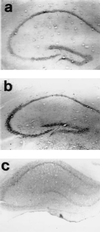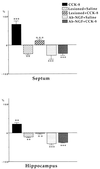Cholecystokinin-8 protects central cholinergic neurons against fimbria-fornix lesion through the up-regulation of nerve growth factor synthesis
- PMID: 10339612
- PMCID: PMC26906
- DOI: 10.1073/pnas.96.11.6473
Cholecystokinin-8 protects central cholinergic neurons against fimbria-fornix lesion through the up-regulation of nerve growth factor synthesis
Abstract
In this study, we demonstrate that cholecystokinin-8 (CCK-8) induces an increase in both nerve growth factor (NGF) protein and NGF mRNA in mouse cortex and hippocampus when i.p. injected at physiological doses. By using fimbria-fornix-lesioned mice, we have also demonstrated that repeated CCK-8 i.p. injections result in recovery of lesion-induced NGF deficit in septum and restore the baseline NGF levels in hippocampus and cortex. Parallel to the effects on NGF, CCK-8 increases choline acetyltransferase (Chat) activity in forebrain when injected in unlesioned mice and counteract the septo-hippocampal Chat alterations in fimbria-fornix-lesioned mice. To assess the NGF involvement in the mechanism by which CCK-8 induces brain Chat, NGF antibody was administrated intracerebrally to saline- and CCK-8-injected mice. We observe that pretreatment with NGF antibody causes a marked reduction of NGF and Chat activity in septum and hippocampus of both saline- and CCK-8-injected mice. This evidence indicates that the CCK-8 effects on cholinergic cells are mediated through the synthesis and release of NGF. Taken together, our results suggest that peripheral administration of CCK-8 may represent a potential experimental model for investigating the effects of endogenous NGF up-regulation on diseases associated with altered brain cholinergic functions.
Figures



Similar articles
-
NGF released from a polymer matrix prevents loss of ChAT expression in basal forebrain neurons following a fimbria-fornix lesion.Exp Neurol. 1990 Oct;110(1):39-44. doi: 10.1016/0014-4886(90)90049-x. Exp Neurol. 1990. PMID: 2209780
-
Direct, complex effects of estrogens on basal forebrain cholinergic neurons.Exp Neurol. 2005 Aug;194(2):506-22. doi: 10.1016/j.expneurol.2005.03.015. Exp Neurol. 2005. PMID: 15893308
-
Acetylcholine-rich transplants in the hippocampus: influence of intrinsic growth factors and application of nerve growth factor on choline acetyltransferase activity.Brain Res. 1985 Oct 14;345(1):141-6. doi: 10.1016/0006-8993(85)90844-3. Brain Res. 1985. PMID: 4063798
-
[Nerve growth factor strategy and preparation of animal model for Alzheimer-type senile dementia].Yakugaku Zasshi. 1995 Jul;115(7):499-512. doi: 10.1248/yakushi1947.115.7_499. Yakugaku Zasshi. 1995. PMID: 7562397 Review. Japanese.
-
Cholecystokinin-8 and nerve growth factor: two endogenous molecules working for the upkeep and repair of the nervous system.Curr Drug Targets CNS Neurol Disord. 2002 Oct;1(5):495-510. doi: 10.2174/1568007023338978. Curr Drug Targets CNS Neurol Disord. 2002. PMID: 12769602 Review.
Cited by
-
Cholecystokinin-8 enhances nerve growth factor synthesis and promotes recovery of capsaicin-induced sensory deficit.Br J Pharmacol. 2000 Feb;129(4):744-50. doi: 10.1038/sj.bjp.0703088. Br J Pharmacol. 2000. PMID: 10683199 Free PMC article.
-
Delivery of neurotrophic factors to the central nervous system: pharmacokinetic considerations.Clin Pharmacokinet. 2001;40(12):907-46. doi: 10.2165/00003088-200140120-00003. Clin Pharmacokinet. 2001. PMID: 11735609 Review.
References
Publication types
MeSH terms
Substances
LinkOut - more resources
Full Text Sources
Other Literature Sources

